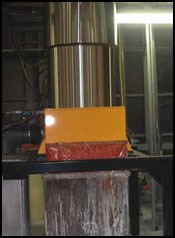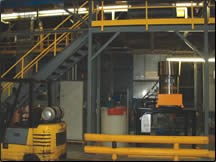Keeping E-Coat Clean
Centrifugal filtration improves process and reduces operating costs
MetoKote Corp. (Lima, OH) operates dozens of plants around the world to provide electrocoating, powder coating, liquid paint and other finishing services to a list of more than 1000 customers.
One of those customers is Tower Automotive, a producer of body structures, lower vehicle structures, and suspension components for nearly every major global automaker. At Tower’s Plymouth, MI, plant, the company fabricates frames for pickups and SUVs built by a Big Three automaker. MetoKote operates an e-coat facility to paint the frames on site, literally in the same building as Tower. It’s a concept Metokote calls InSite, in which Metokote provides design, fabrication, installation, ramp-up, and operation of the coating line inside a customer’s plant.
The process paints six frames at a time, and normally operates two shifts a day, five days a week. Total cycle time is roughly two hours—about an hour through the e-coat line and an hour in curing—to produce a nominal film thickness of 0.8 mils.
Pretreatment Problems
Before e-coat, of course, frames must be pretreated. At Plymouth, pretreatment is a multi-stage process consisting of an alkaline cleaner, city water rinse, rinse conditioner, zinc phosphate, city water rinse, non-chrome sealer, and two rinses with deionized water. Pretreatment takes place in a series of 17,000-gal tanks.
According to Metokote Northern Region General Manager Bill Holloway, keeping the pretreatment tanks clean was presenting a problem. “The natural chemical reaction between the zinc phosphate and steel creates sludge, which rapidly builds in the tank,” says Holloway. “If the tanks aren’t kept clean, the sludge will cling to the frames and cause quality problems.”
MetoKote initially developed a proprietary filtering system to reduce the amount of sludge and waste in its dip tank. “Essentially, it was two gravity filter bed systems consisting of continuous rolls of 60-in. indexing filter paper constantly screening the contents of the tank to keep it as clean and as sludge-free as possible,” plant manager Dave Haefner explains.
The system was effective for larger particles, but it didn’t filter fine particulates, very well. And, MetoKote managers were looking for ways to reduce costs. The cost of paper filter media and waste disposal weren’t the only issues: the gravity units created a lot of steam over the phosphate bath, necessitating water replenishment twice a shift, and the phosphate bath also lost heat during its exposure to air, increasing energy costs. The phosphate tank also needed to be completely drained and cleaned every six to nine months.
Centrifugal Solution
Looking for a replacement for the paper filters, MetoKote managers found it at a trade show in Indianapolis in the form of a centrifugal filtration system supplied by CentraSep (Indianapolis). “Initially we were reluctant, because it seemed almost too good to be true,” recalls Holloway. “But we looked at other companies and no one else offered what CentraSep did, so we decided to take them up on their trial program.”
The company’s patented centrifugal unit generates up to 2012 Gs to provide particulate removal capabilities that exceed traditional media filtration technologies such as gravity bed filters. It consists of a single-motor vertical self-discharging centrifuge. According to CentraSep, other vertical self-discharging centrifuges require two motors and relatively complex drive mechanisms. The company says use of a single motor with a single proprietary clutch design reduces complexity and provides reliability and efficiency advantages compared to other centrifuges and other filtration technologies.
Controlled by a PLC and a dedicated drive using solution-specific firmware, the unit generates the torque required to automatically discharge the collected waste during the scrape cycle. This combination provides reliability and equipment protection not found with two-motor-style centrifuges. Other vertical self-discharging centrifuges use gear motors to generate torque, which can lead to component failure and broken parts in an overload condition.
Multiple Benefits
At the Plymouth facility, the CentraSep trial unit was installed on a side-stream kidney loop running independent of the line so it would continue to process the bath even when the e-coat line wasn’t running.
The centrifugal filtration process is contained, so it doesn’t expose the phosphate bath to the atmosphere while filtering. This helps to maintain the phosphate bath’s temperature of 125° and substantially reduces the amount of makeup water and chemicals needed to replenish the phosphate tank. Water additions are now limited to about 200 gal at the end of the day, according to facility maintenance manager Todd Gibbish.
“With the centrifugal system and the lower water content of the CentraSep sludge, we’ve greatly reduced make-up water usage and scale build up, so the boiler isn’t working so hard to maintain bath temperature,” Gibbish explains. “While we can’t put an exact number on the energy savings because the boiler feeds other parts of the facility, we know the savings are significant.
“Consistency is key to production and quality,” Gibbish continues. “If the bath temperature is not maintained at a steady state, we have to increase the concentration of chemical or make other adjustments to allow the bath temperature to come back into range. With the CentraSep unit, our ability to maintain heat is greatly improved. With the bath temperature more consistent, we have reduced the need to monitor and adjust chemical make-up. Plus, with a cleaner phosphate tank, there’s been a reduction in the amount of solids carried over into our rinse bath.”
According to Gibbish, training and setup were simple after some initial experimentation with the unit and its associated pump and plumbing. “The first pump we had really didn’t work very well,” he recalls. The current one is a magnetic drive pump with no seals—there’s no way it can leak. And it pulls from two different parts of the tank so we’re not relying on trying to get all the sludge in one area.
The process is set up to pull from one side of the tank for 30 min, then automatically switch to the other side for thirty minutes. The entire filter cycle lasts 80-90 min, including stoppage of the centrifugal unit, disengagement of the clutch, and reversal of the motor to scrape accumulated sludge from the inside of the unit. Sludge drops directly into a hopper under the unit.
“The unit processes based on time,” Gibbish explains. “What we didn’t know at first was how long we needed to run the cycle before we stopped and scraped the sludge off the inside of the unit. It took some time to understand that. Plus, we had to adjust the pickup locations in the tank to find the sweet spot. That took some time, but since then the system has worked well.”
Current plans call for connecting the filtration system into the line’s control system to avoid any unnecessary processing on weekends or during other shutdowns. “When we’re not here, we’re not producing sludge,” Gibbish says. “We’re going to tie the unit in to our rectifier so that it doesn’t run all weekend but kicks in automatically when we start the system on Monday morning.”
According to Gibbish, the unit has required very little maintenance. “Training and setup were simple,” he recalls. “We really only had to learn some basic on/off procedures. There’s just not a lot to it from a training standpoint.”
Preventive maintenance is easy as well. “If we’re running normally at the plant, the line is running about 16 to 17 hours per day, five days a week,” says Haefner. “We’ve had no maintenance issues of any kind with CentraSep.”
“We follow some simple procedures that they showed us, but frankly there is just not much we need to do,” Gibbish explains. “Other than emptying the hopper and occasionally cleaning the strainer that protects the pump inlet, we’ve really done nothing since installation.”
A scheduled clutch lubrication that takes less than 15 min is performed twice a year, and Gibbish reports that Metokote plans to exchange the unit’s rotor as recommended. “We’ve got a rotor exchange scheduled, just to see how everything is looking inside the unit,” he says. “We’ve been operating it close to a year and a half.”
The unit’s small footprint also freed up a substantial amount of floor space. Gibbish says he hopes to move the facility’s into the space adjacent to the line that was previously taken up by the old filtration system.
The Bottom Line
The centrifugal unit is performing up to expectations, and payback took about one year, according to Haefner. “The main reason we got the unit was to take more sludge out of the tank than the filter beds allowed us to,” says Haefner. “We also liked that the sludge that it removed was drier, returning more liquid back to the tank instead of holding it in the sludge like our old system. It costs more to dispose of the wet sludge, since you pay for its removal by weight. And environmentally speaking, the drier it is, the safer it is.”
According to Gibbish, the old filter system generated four hoppers of waste per week, and each hopper was roughly twice the size of the current hopper. The current hopper is changed about twice a week—a four-fold reduction in waste generated.
Elimination of the paper filter media also generated savings. “Obviously, the filter paper on our old system was not reusable. Once that filter paper was used, you’d have to throw it out and start over,” says Gibbish. “So we also have a labor reduction and a purchase reduction, because the CentraSep is not using any kind of filter media.” On the old system, filters required changing once a week when the line was busy, he adds.
Pulling more sludge from the tank has also reduced tank maintenance. In the past, the plant would drain the phosphate tank, remove accumulated sludge, and recharge the tank about every six to nine months. “Cleaning the tank was a six-to-eight-hour job,” recalls Haefner. “We normally brought in an outside company to help. It was a $6,000 to $8,000 affair just for disposal costs. So, if we avoid the need to clean the tank because of the extra filtration the CentraSep unit offers, that’s a $6,000 or $8,000 savings every time.”
Success of the centrifugal filtration system at Plymouth has prompted Metokote to consider a wider rollout of the technology in some of its other facilities, according to CentraSep.
Related Content
An Altruistic Growth Strategy Puts People First
Professional Plating emphasizes investing in its team and fostering a supportive environment on the shop floor.
Read MoreFinishing Systems Provider Celebrates 150 Years, Looks to Future
From humble beginnings as an Indiana-based tin shop, Koch Finishing Systems has evolved into one of the most trusted finishing equipment providers in the industry.
Read MoreTTX’s Automated Conveyor Carrier System Offers Wireless, Flexible Operation
ACC system designed for reliable, consistent point-to-point movement of everything from small to heavy parts.
Read MoreConveyors and Paint Systems
Choosing the right conveyor system, coating technology, and ancillary equipment.
Read MoreRead Next
A ‘Clean’ Agenda Offers Unique Presentations in Chicago
The 2024 Parts Cleaning Conference, co-located with the International Manufacturing Technology Show, includes presentations by several speakers who are new to the conference and topics that have not been covered in past editions of this event.
Read MoreEpisode 45: An Interview with Chandler Mancuso, MacDermid Envio Solutions
Chandler Mancuso, technical director with MacDermid Envio discusses updating your wastewater treatment system and implementing materials recycling solutions to increase efficiencies, control costs and reduce environmental impact.
Read MoreEducation Bringing Cleaning to Machining
Debuting new speakers and cleaning technology content during this half-day workshop co-located with IMTS 2024.
Read More
























